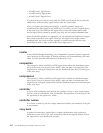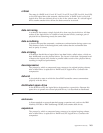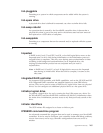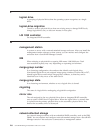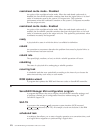
critical
The state of a RAID level-1, level-1E, level-5, level-5E, level-5EE, level-10, level-1E0,
or level-50 logical drive that contains a defunct drive. A RAID level-6 or level-60
logical drive with two defunct drives is also in the critical state. If a critical logical
drive sustains another drive failure the data cannot be recovered.
D
data mirroring
A technique that creates a single logical drive from two physical drives. All data
written to the logical drive is written to both physical drives, creating a pair of
physical drives containing exactly the same data.
data scrubbing
A feature that provides automatic, continuous synchronization during system use.
This features works in the background, and ensures that the redundant data
and/or parity is correct.
data striping
A technique that divides a logical drive into data blocks, called stripes, which are
then distributed over the physical drives. The layout is such that a sequential read
of data on the logical drive results in parallel reads to each of the physical drives,
resulting in improved performance.
decompression
The process by which a compressed array returns to its original striping scheme,
after a failed drive is replaced in a RAID level-5E logical drive. Contrast with
compression.
defunct
A physical-drive state in which the ServeRAID controller cannot communicate
properly with the drive.
distributed spare drive
In the RAID level-5E, the logical drive designated as a spare drive. Because this
spare drive is spread over several physical drives, it is described as distributed.
E
enclosure
A direct-attached or network-attached storage expansion unit, such as the IBM
Netfinity EXP300 or IBM TotalStorage DS300, that contains disk drives.
expansion
The process by which a compacted array returns to its original striping scheme,
after a failed drive is replaced in a RAID level-5EE logical drive. Contrast with
compaction.
Appendix B. Glossary 263










